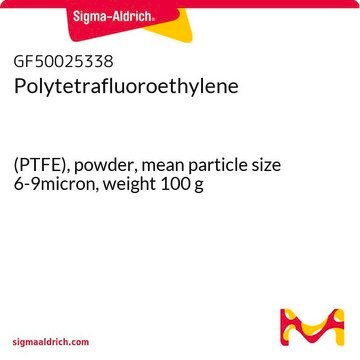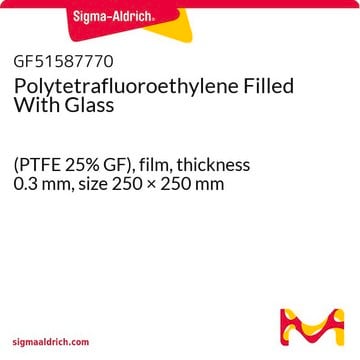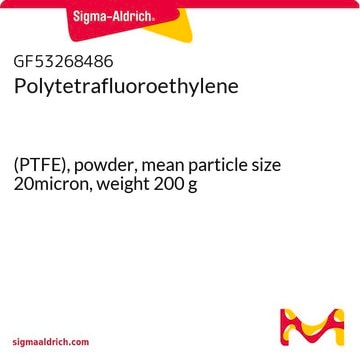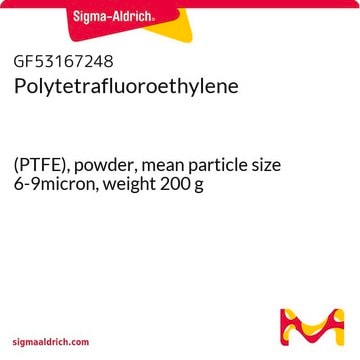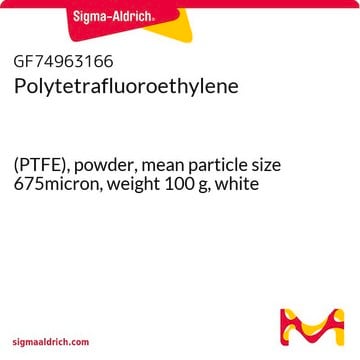Precipitates may form over time while standing and can be re-dispersed by gentle agitation. Containers may be rolled or the product shaken gently just before use. High-speed agitation, pumping, or other violent agitation should be avoided to limit shearing or coagulation of particles and to minimize foaming. Precipitation may also occur if the product undergoes vigorous agitation or is exposed to high or low temperatures. The recommended temperature range is +7 to +24 °C. If particulates remain after gentle mixing, it may indicate irreversible aggregation. For further discussion, please visit https://www.sigmaaldrich.com/techservice and click on "Product Technical Inquiries" under the Products Section with all the required information for assistance from the Technical Service team.
665800
Polytétrafluoroéthylene preparation
60 wt % dispersion in H2O
Synonyme(s) :
Dispersion PTFE
Sélectionner une taille de conditionnement
Sélectionner une taille de conditionnement
About This Item
Produits recommandés
Niveau de qualité
Concentration
60 wt % dispersion in H2O
Chaîne SMILES
FC(=C(F)F)F
InChI
1S/C2F4/c3-1(4)2(5)6
Clé InChI
BFKJFAAPBSQJPD-UHFFFAOYSA-N
Vous recherchez des produits similaires ? Visite Guide de comparaison des produits
Description générale
Application
L'invariance de la constante diélectrique sur une large gamme de fréquence et la grande rigidité diélectrique du PTFE en font un matériau adapté à l'isolation des câbles et au stockage d'énergie à haute température.
Il peut aussi servir de revêtement facile à nettoyer, chimiquement inerte et anti-adhérent dans l'industrie alimentaire, chimique et pharmaceutique.
Caractéristiques et avantages
- Grande résistivité chimique
- Faible coefficient de frottement
- Flexibilité
- Grande stabilité thermique
Mention d'avertissement
Danger
Mentions de danger
Conseils de prudence
Classification des risques
Eye Dam. 1
Code de la classe de stockage
10 - Combustible liquids
Classe de danger pour l'eau (WGK)
WGK 3
Point d'éclair (°F)
Not applicable
Point d'éclair (°C)
Not applicable
Équipement de protection individuelle
Eyeshields, Gloves, type ABEK (EN14387) respirator filter
Faites votre choix parmi les versions les plus récentes :
Certificats d'analyse (COA)
Vous ne trouvez pas la bonne version ?
Si vous avez besoin d'une version particulière, vous pouvez rechercher un certificat spécifique par le numéro de lot.
Déjà en possession de ce produit ?
Retrouvez la documentation relative aux produits que vous avez récemment achetés dans la Bibliothèque de documents.
Les clients ont également consulté
-
When the emulsion was delivered, there was sediment at the bottom. Is this normal, or is it defective?
1 réponse-
Utile ?
-
-
What is the viscosity of the dispersion?
1 réponse-
The viscosity of this material is not tested on a lot-to-lot basis. However, historical data indicates a viscosity of approximately 20 cP at 25°C.
Utile ?
-
-
How is shipping temperature determined? And how is it related to the product storage temperature?
1 réponse-
Products may be shipped at a different temperature than the recommended long-term storage temperature. If the product quality is sensitive to short-term exposure to conditions other than the recommended long-term storage, it will be shipped on wet or dry-ice. If the product quality is NOT affected by short-term exposure to conditions other than the recommended long-term storage, it will be shipped at ambient temperature. As shipping routes are configured for minimum transit times, shipping at ambient temperature helps control shipping costs for our customers. For more information, please refer to the Storage and Transport Conditions document: https://www.sigmaaldrich.com/deepweb/assets/sigmaaldrich/marketing/global/documents/316/622/storage-transport-conditions-mk.pdf
Utile ?
-
-
How can I determine the shelf life / expiration / retest date of this product?
1 réponse-
If this product has an expiration or retest date, it will be shown on the Certificate of Analysis (COA, CofA). If there is no retest or expiration date listed on the product's COA, we do not have suitable stability data to determine a shelf life. For these products, the only date on the COA will be the release date; a retest, expiration, or use-by-date will not be displayed.
For all products, we recommend handling per defined conditions as printed in our product literature and website product descriptions. We recommend that products should be routinely inspected by customers to ensure they perform as expected.
For products without retest or expiration dates, our standard warranty of 1 year from the date of shipment is applicable.
For more information, please refer to the Product Dating Information document: https://www.sigmaaldrich.com/deepweb/assets/sigmaaldrich/marketing/global/documents/449/386/product-dating-information-mk.pdfUtile ?
-
-
Hi, Could you please let me know the density of the solution and the size of the PTFE particles in the solution? Thanks.
1 réponse-
The density of this product is not determined on a lot to lot basis. However, a 60 wt% dispersion will have a density of 1.5 g/mL. The concentration of this dispersion may vary slightly from lot to lot. The particles have an average diameter of 0.220 um and may range from 0.150 - 0.500 um.
Utile ?
-
-
Hi, Can you tell me if this product is AD 309 E PTFE dispersion from AGC?
1 réponse-
Unfortunately, the supplier information is considered proprietary. The measured properties are published in the product Certificate of Analysis. Please see the link below to review a sample or lot-specific Certificate:
https://www.sigmaaldrich.com/product/aldrich/665800#product-documentationUtile ?
-
-
What is the boiling point of the product?
1 réponse-
This product is a 60% dispersion of PTFE in water. The boiling point has not been determined. The PTFE particles may settle at temperatures greater than 66°C, but can be redispersed by mild agitation. The melting peak temperature for these particles is 337°C.
Utile ?
-
-
What is the molecular weight of the polymer?
1 réponse-
Unfortunately, the molecular weight of this product is not determined.
Utile ?
-
-
What are the recommended processing conditions for 665800-100ML?
1 réponse-
The product 665800 PTFE dispersion retains its properties after exposure to 260 °C (500 °F). Processing guidelines entail using conventional dip or flow techniques for coating or impregnating high-temperature fabrics, fibers, and other products. Multiple passes can be used to achieve the desired thickness for a smooth, crack-free coating. Each coating layer is typically dried at 120 °C (250 °F) to remove water, baked at 270 °C (518 °F) to eliminate the wetting agent, sometimes calendered, and finally heated above the crystalline melting point of the resin particles, which is approximately 337 °C (639 °F).
Utile ?
-
-
what is the curing temperature? if it used to make thin film for detect oxygen concentration of aqueous
1 réponse-
665800 is PTFE dispersion in water. The curing temperature depends on its further applications. Generally, 80-100 °C should be good. Unfortunately, it hasn't been tested for the application of oxygen concentration detection.
Utile ?
-
Filtres actifs
Notre équipe de scientifiques dispose d'une expérience dans tous les secteurs de la recherche, notamment en sciences de la vie, science des matériaux, synthèse chimique, chromatographie, analyse et dans de nombreux autres domaines..
Contacter notre Service technique

![Poly[4,5-difluoro-2,2-bis(trifluoromethyl)-1,3-dioxole-co-tetrafluoroethylene] dioxole 87 mol %](/deepweb/assets/sigmaaldrich/product/structures/951/320/21327fcd-4960-402d-8ae1-bf2e379cb2e2/640/21327fcd-4960-402d-8ae1-bf2e379cb2e2.png)
